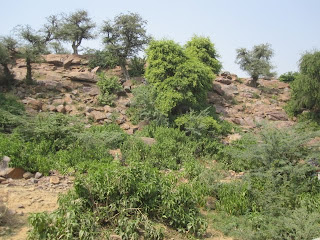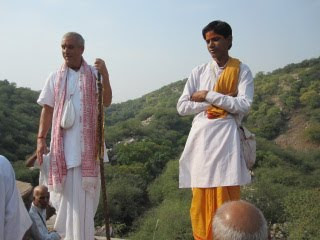Radharani's Compassion
Sundara Lala
Vrindadevi Astaka 2
Ter Kadambha 1
Ter Kadambha 2
Yesterday was Gopastami. We discovered a most wonderful place, namely the goshala of the 'Care for Cows' project in Vrindavan, which is run by Kurma Rupa Prabhu. There we had a great photo session with a one week old calf. He was so sweet and cute that one could hardly leave him.
Care for Cows in Vrindavan maintains abandoned cows, bulls, retired oxen, and orphaned calves. It is run by international volunteers who offer their talents and resources to tend to the neglected cows living in Krishna's holy land. They provide stray cows hay, flour, fresh grass, medical attention and a place where they can recuperate from injuries. At present they host a herd of three hundred.
There are approximately three to four hundred abandoned cows in Vrindavan requiring accommodation. Unless they are protected they are destined to subsist on refuse and become plagued by various debilitating and often terminal diseases or suffer injury from careless motorists. However, the most immediate danger is that they become abducted for slaughter by cattle rustlers who are active in this area today.
Gopastami marks the day when Krishna was given the responsibility to herd the grownup cows. To mark this occasion a go puja ceremony had been conducted by offering arati, i.e. incense, a lamp, water, flowers, a chamara and fan to a cow, who had a new born calf with her. After the ceremony everyone had the opportunity to feed the cows, bulls and calves with laddus, bananas and gour. They were very eager and excited and relished such and an opulent treat. Devotees could also brush and pet the cows to their heart's desire.
Cows are amazingly affectionate animals, who eagerly reciprocate the love they receive. We in turn felt we could stay the whole day at the goshala to pet, hug and feed the cows. During all of this a group of devotees sang beautiful bajans and kirtans. Obviously the cows liked that too. We felt this was the highlight of our stay in Vrindavan. We have taken many photos and short video clips, which we will share with you on our return.
The goshala has also five antelopes. Sometimes one can see an antelope on Govardhan Hill during parikrama. When grownup they have an almost dark-bluish colour. Therefore they are also known as blue cows. The antelopes have a similar mentality to cows and therefore mix with them easily.
The crowning of the day was a delicious prasadam feast with rice, dahl, two subjis, chutney, puris, gulabjamuns and sweet rice, all served on traditional leaf plates and leaf cups and in an atmosphere so peaceful and tranquil that one was able to get a small but real glimpse of the spiritual world. Kurma Rupa Prabhu explained that pleasing cows is the easiest way to please Krishna. After all Krishna is a transcendental cowherd boy and the cows are more dear to him than even the brahmanas. Pleasing the cows is also not difficult. One can easily do so by simply stoking or feeding them. Kurma Rupa Prabhu publishes a monthly newsletter with beautiful photos, which no one should miss to read. It maintains one's connection with Krishna's cows and Vrindavan.
Tomorrow is our last day in Vrindavan and this may well be our last blog entry from the Holy Dham. I hope you enjoyed reading it. Thank you for following us all along our pilgrimage, which kept us inspired to write this blog despite a terribly slow Internet connection. We are leaving around 9 PM by taxi to catch our flight in Delhi in the early hours of Thursday morning. Thinking of leaving Vrindavan we are overcome with mixed feelings of separation and the desire to see all of you in Leicester and share some of the nectar and inspiration we have so plentifully received from here.
I remember the wonderful welcome from Dina Bandhu Prabhu on the day of our arrival. Seeing me in the temple room he gave me a big hug and said: "Hey Gauranga Baba, welcome to Braj." It seems only a few days have passed since then. I truly don't know where the days have gone but I feel fortunate that we had the opportunity to have a peek into Krishna's backyard and to associate with so many wonderful Vaishnavas from all over the world. We made new friends and deepened our friendship with old ones. Vrindavan is certainly a place where affection flows easily, - to the cows, the devotees, the dogs and even the monkeys, despite them being so mischievous that they chewed up Varshana's glasses.
I also remember the moment I stood in front of Radha Syamasundara thinking if Radharani has forgotten me or still remembers me. It had been three years since our last visit. The next moment the pujari placed a flower garland around my neck in confirmation that Radharani, the queen of Vrindavan, has welcomed us to Her Holy Dham. A few days later I tried this 'magic' with Krishna and Balarama also and in a moments time I had a garland around my neck too. Krishna and Balarama ki jaya! Sri Sri Radha Syamasundara ki jaya! Sri Vrindavan Dham ki jaya! All glories to all the devotees of Lord Caitanya! All glories to Srila Prabhupada, who so kindly introduced us to Sri Vrindavan Dham.


















